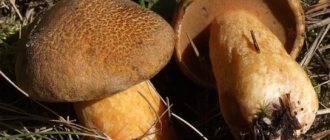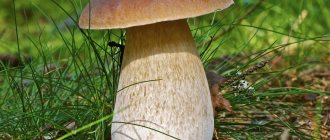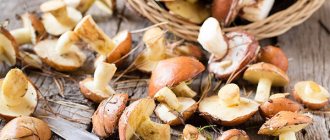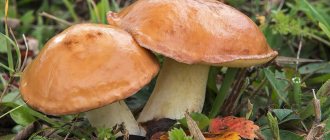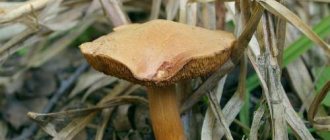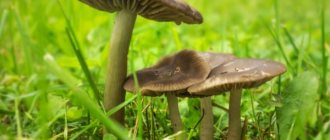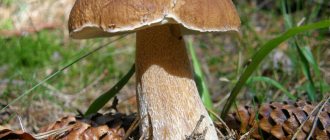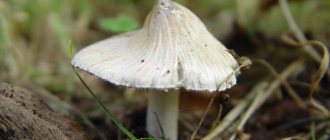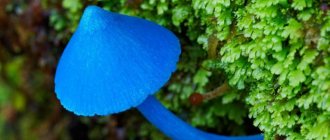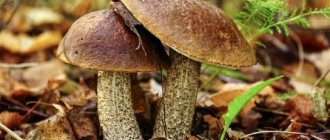Among the abundance of forest mushrooms, the granular oiler especially stands out. It grows at the very beginning of June. This is a very beautiful and noticeable mushroom that is difficult not to notice. If you are going on a quiet hunt, it is important to know what exactly the granular oiler looks like, so as not to confuse it with other forest inhabitants. But the granular oil dish perfectly combines medicinal properties and beneficial substances, due to which it is widely used in folk medicine
From Latin - Suillus granulatus.
Description and photo Grain oiler
It is important to find out what the granular oiler looks like so as not to confuse it with other forest inhabitants. Unfortunately, the appearance of this mushroom resembles some of its poisonous counterparts, the collection of which can lead to serious health problems. Let us consider in as much detail as possible how the granular oiler differs from its counterparts. Also known as summer butterfly, early butterfly.
hat
The first thing that distinguishes the granular oiler from other forest inhabitants is its cap. She is very unique and interesting, unlike anyone else.
I must say that the butterdish mushroom is quite large in its parameters. Its cap can reach as much as 20 cm in diameter. It is very large and fleshy, and has a convex shape, both below and above.
The skin on top is very smooth, often covered with mucus, in which insects get stuck. If the mushroom is located on a sunny edge, and not in the shade, then the cap begins to crack over time, and wounds and scratches appear on it.
The color of the cap varies depending on the soil in which it grows. If the soil is saturated with minerals, the color is yellow-brown. On sandy soils, the cap becomes ocher, sometimes even brown.
It seems very easy to separate from the pulp, so often, in adulthood, the mushroom becomes like a multi-layered skirt, since it seems that the top layer rises up.
Records
The plates of the mushroom are expressed by small holes at the bottom of the cap, similar to a sponge. This is where the disputes are located.
They are quite fleshy, have a yellowish tint, less often brown or brown.
If a mushroom is cut in half, milky juice will be released in the cut, and the flesh will be yellow. Under the influence of oxygen, the color does not change, it only fades a little.
Leg
The stem of the mushroom is stable and cylindrical in shape. It is smooth, but unevenly colored, with alternating light and dark stripes. The height of the stem can raise the mushroom up to 8 cm. The diameter is small, up to 2 cm, but it is very stable and practically not curved.
The stem releases droplets of liquid closer to the cap. At first they are white, but then when dry they turn yellow and form small spots, like grains.
Pulp
The pulp of the mushroom is very dense and even at an old age does not become hollow. Maximum elasticity, smells pleasantly sour, sometimes even fruity.
In cross section it is yellow; when interacting with oxygen, the color does not change. Elastic, stretches well, cuts without problems.
With age, the pulp rises, removing the skin of the cap from the main mushroom. It is for the flesh of the cap that this mushroom is so valued in folk medicine. It is used in the preparation of numerous decoctions, lotions and other medicines.
Despite its volume, the cap dries well, which means it can also be used in powder form.
Edibility of Summer Buttercup
According to encyclopedias, the mushroom belongs to the second category of edibility. This means that it requires virtually no preparation.
Granular or summer butterdish is a wonderful mushroom in terms of its taste. It can easily be fried, stewed, boiled, salted and used in any other way, most importantly, not fresh.
Available on Wikipedia.
However, it is still worth making some preparation before use.
- To begin with, the boletus is cleaned of all forest debris in the form of forest needles, insects, soil, and so on.
- The next steps are to rinse it well under running cold water.
- The skin of the cap must be removed, since a mucous layer remains on it, which during growth accumulated dust, raindrops, as well as other components that are not very useful for the human body.
- After the skin of the cap has been removed, the mushroom can be boiled, stewed, fried, or subjected to other heat treatment methods.
This mushroom is absolutely safe and edible. It is collected in Russia, CIS countries and Europe. Everywhere it is considered an excellent addition to other products.
No mention was found of anything that negatively affects human health.
Article on the topic - White butterfly mushroom (pale): photo and description of what it looks like.
How to cook
You have read the description of edible species, seen their photos, now it’s your turn to tell us how to cook this unique mushroom.
These mushrooms are one of the favorite varieties for cooks. Not only adults, but also children love them.
There are many ways to process butter. They can be pickled, fried, boiled. Below we describe examples of different ways to prepare these “slimy goodies.”
Soup
The soup made from them is very light and lean. After eating 100 grams of soup, a person will receive only 90 kilocalories.
To prepare it, you will need:
- 350 grams of mushrooms.
- 450 grams of potatoes.
- One carrot.
- One onion.
- A couple of bay leaves.
- 2 tablespoons of vegetable oil.
- Salt and spices to taste.
The recipe is extremely simple. It is prepared in the same way as other soups. First, potatoes are boiled, spices, fried onions and potatoes are added, and finally fried butter is added.
Capacity
There are a lot of recipes for making pickled butter. For one of them you will need:
- One kilogram of mushrooms.
- Half a liter of water.
- One tablespoon of sugar.
- Two teaspoons of salt.
- One bay leaf.
- Black and allspice 2-3 pieces.
- 2 pieces of cloves.
- 6% vinegar – 50 ml.
- 1-2 cloves of garlic.
The oils are pre-cleaned and washed well. Then they are boiled for 20 minutes in salted water. To prevent the mushrooms from darkening, you can add a little citric acid to the water.
After the mushrooms are cooked, you need to prepare the marinade. To do this, take a saucepan and pour into it all the ingredients described above except garlic and vinegar. Place this on the fire and bring to a boil. When the mixture boils, add butter and cook for 30 minutes. Five minutes before removing the pan from the heat, add vinegar to the marinade.
Then all this is sorted into banks. The jars are pre-sterilized. Place a clove of garlic at the bottom of the jars, and pour the marinade on top of it.
Similar species
In the forest you can also find other mushrooms that look like granular butterdish. He is so similar to his brother that sometimes it is not clear who appeared before the mushroom picker. Let's look at which mushrooms are similar to their granular counterpart, whether they can be collected or whether it is dangerous.
Real oiler
A very beautiful and spectacular mushroom. It has a brown cap, somewhat darker in color than its grainy counterpart. It is glossy and absolutely smooth. The pulp is voluminous, but not as voluminous as that of a grainy butter dish.
The main difference between mushrooms is the small skirt that a real butterdish has. It is quite voluminous and clearly visible.
However, the real butter dish is also edible and if you collect it instead of the grainy one, you will not harm your health.
Cedar oiler
This mushroom is famous for the fact that its cap has a semi-spherical shape. However, by the middle of the season it becomes like a big pillow. The diameter of this variety ranges from 3 to 15 cm, that is, the mushrooms are very noticeable.
The color is brown, less often beige. The mushroom prefers to grow in humid conditions, and very often mucus accumulates on its cap.
If the weather is very sunny, the mucus dries out and the coating becomes waxy.
The flesh of this mushroom is slightly sour, but the taste is very pleasant. Grows in Siberia.
Oiler dirty
This mushroom with a fancy name grows in the southern part of Russia, as well as in Western Europe. This fungus enters into strong mycorrhiza with pine trees, less often with cedars or larches.
They are not found in the northern part, but are common in Estonia, Germany and Denmark. The fungus is listed in the Red Book in a number of countries. The hat is large, up to 15 cm.
Swamp mushroom
This lookalike is also edible, the main difference being the size. The marsh mushroom's cap is very small and bell-shaped.
Mycorrhiza enters with coniferous plants.
Oiler not ringed
It differs in that it has a more voluminous leg and a less voluminous cap.
It has a somewhat pale color, and the leg at the base is pinkish. The legs resemble barrels, which are crowned with a small hat.
The red oiler has a stalk that is darker than that of the granular mushroom. But the hat, on the contrary, is bright red or yellow, glossy, and looks like a closed umbrella.
Not as voluminous, but smells delicious.
In general, if you want to understand that this is a grainy oil dish, then smell its flesh. In a grainy or summer oiler, it smells fruity, acidic, but at the same time very pleasant. Other mushrooms from the boletus family have a mealy or mushroom smell. This is the main difference
Unfortunately, the summer butterfly has poisonous mushroom counterparts. This means that when collecting such mushrooms there is a high risk of poisoning.
Among their poisonous counterparts there are brown or yellow boletus. The difference is again in taste and smell. They are very unpleasant, they smell like humus.
Also, summer butterfly is often confused with pepper mushroom, despite the fact that it is not poisonous, but is still very unpleasant to cook.
Another variety is larch or gray oiler. It is not recommended to collect it, since scientists are still arguing about its safety for the human body, and we, in turn, do not recommend experimenting.
Poisonous doubles
Granular mushrooms can be mistakenly confused with other species, but among similar ones there are no poisonous fruiting bodies. Among the conditionally edible or inedible butterflies, the yellow-brown type should be distinguished. These mushrooms have an extremely unpleasant taste, so mushroom pickers try to ignore them. In addition, summer butterfly can be confused with pepper mushroom, which has a bitter and unpleasant taste. However, this species is not poisonous.
Another similar variety is larch oiler (gray). It is not advisable to collect it, because there is no information yet about its benefits or harm.
Where and at what time does it grow?
Where to look for summer butterdish?
It is believed that this mushroom grows in large pine forests, less often in deciduous ones. It can be found on the edges, in parks and alleys. Loves damp areas, as well as soils rich in humus.
Hides in the grass or grows among imha. Rarely found near rotting wood. Distributed throughout central Russia, it is especially abundant in the Caucasus mountains.
It grows in the CIS countries, as well as throughout Western Europe. This mushroom can grow either singly or in fairly large groups.
It is recommended to go looking for an oiler at the very beginning of June.
Mushrooms will delight you for a month and a half, but by the beginning of July it is almost impossible to find them. Much also depends on the air temperature and the environment. If the summer turns out to be hot, then the oil can disappears faster, and by mid-June it is practically impossible to find.
Places of distribution
Granular oiler grows in groups. Most often, these mushrooms are found among aspens and coniferous forests. Their mushroom spots can only be found on soils that contain large amounts of lime. In most cases, the collection sites of this variety are localized in a sandy bud in forests where pine trees grow, on the edges, clearings, and near paths.
The color of the cut pulp does not change.
The fruiting period begins in June and lasts about 1.5 months. This process is influenced by the presence of climatic precipitation and ambient temperature.
Application in medicine
As mentioned above, larch oiler is widely used in folk medicine. This is because it contains a huge amount of nutrients, vitamins and minerals.
Scientists have found that the fungus contains substances that are classified as antibiotics.
The mushroom is a powerful immunostimulant, so it is good for colds. If we talk about the resin that accumulates on the mushroom cap, it helps perfectly if a person suffers from migraines.
Also in folk medicine there are recipes that help fight the following types of diseases.
- Headache.
- Eye diseases.
- Diseases of the cardiovascular system.
- Disorders of the musculoskeletal system.
- Gout in chronic form.
- Metabolic failure.
- Disease of the central nervous system.
Also, the mushroom is widely used in alternative medicine as a powerful aphrodisiac. Scientists have proven that a mushroom, dried and ground into powder, can increase the tone of the entire body, as well as restore sexual function.
The oil can also helps against various depressive disorders. Helps relieve fatigue, stress, irritability. Scientists have found that the mushroom contains zinc, which means it has a great effect on the ability to reproduce and, in general, reproductive function in general.
Most often, a decoction is made from mushrooms. To do this, it is infused in a small amount of hot liquid for a certain amount of time. Sometimes a tincture is made from mushrooms by mixing them with alcohol-containing products.
Lotions are made from mushrooms, and they are also mixed with other healthy products to enhance the effect. For example, with sunflower oil, wax, viburnum, honey and so on.
Useful properties of the mushroom
Mycologists in many countries have conducted research on mushrooms and have established the presence in edible species of natural antibiotics and substances that stimulate the immune system to produce antibodies.
In addition, the edible body of the butter dish contains:
- vitamins - B2, B5, C;
- minerals - zinc, copper, selenium, chromium;
- protein consisting of valuable amino acids;
- lecithin;
- omega-6;
- resin.
- Pharmacists have adopted this fact and, with the addition of mushroom extract, today prepare medicines for the treatment of:
- metabolic disorders and water-salt metabolism;
- cardiovascular diseases;
- central nervous system problems;
- depression;
- chronic fatigue;
- dysfunction of the reproductive system.
Butternuts have the ability to remove excess fluid and salt from the body , which relieves pain symptoms in joint diseases and reduces swelling of the hands and feet. Regular consumption will restore hormonal levels and prevent PMS in women and impotence in men.
Important! Pediatricians do not recommend giving mushrooms to children under 10 years of age, since before this age the digestive system is not able to absorb such food.
Protein in the product is a building material for cells and tissues and restores the energy balance of the body. Lecithin removes harmful cholesterol, has an analgesic effect, and accelerates cell regeneration processes.
Ascorbic acid has a beneficial, stimulating effect on the body's defenses . Including the product in the diet during seasonal diseases will significantly reduce the risk of their occurrence.
Difference from the later oiler
Some mushroom pickers confuse late butterdish and granular one. The fact is that these forest gifts are very similar to each other and belong to the same genus of the family.
Unlike its granular counterpart, the cap of the later oiler is somewhat larger; its diameter can reach up to 20 cm much more often. It is hemispherical, just like its counterpart, but with age it opens up more, forming a flat umbrella. The top part of the mushroom is very sticky and dust easily sticks to it. The cap is brown, but there is a purple tint here, leaving dark spots. The flesh is the same yellow as its counterpart, but when exposed to oxygen it becomes darker. The spore-bearing layer is not represented by a sponge, like its counterpart, but by small small tubes in which the spore powder is stored. The leg, which is much higher, raises the mushroom to a height of up to 12 cm. The girth is just as stable, up to 3 cm in diameter. The flesh at the stem is quite fibrous, but over time it becomes hollow and can break under the weight of the cap.
It is an edible mushroom, so it is not scary to confuse it with a granular one. However, it is useless in medicine, so if you are looking for a granular one for use in traditional medicine recipes, then its later brother, unfortunately, will not replace it.
